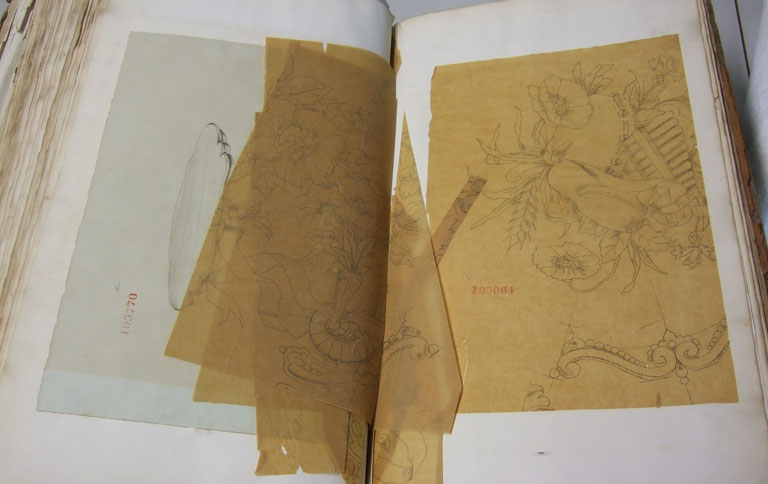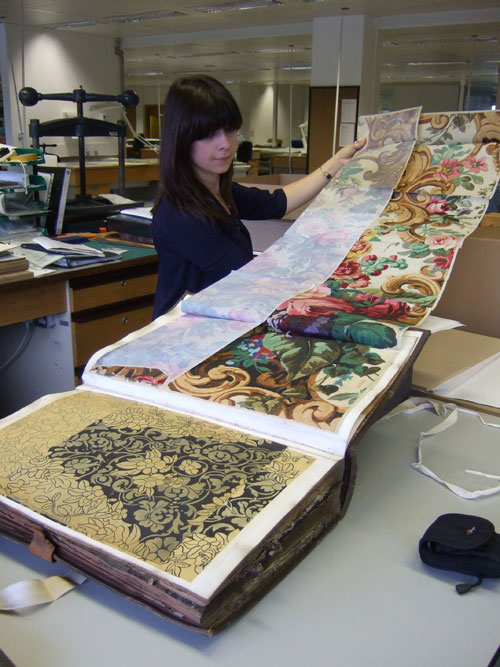Transparent papers, such as tracing paper and vegetable parchment, are a valuable yet fragile resource. Their preservation, required to ensure their accessibility to current and future users, is complicated but can be enhanced by understanding their materials and technology, and their condition and location within The National Archives. Readers are contributing to our understanding of these papers and their distribution via the Readers’ Transparent Paper Survey, as I hope this short report will show.
In an era of modern transparent materials and computer technology, it may be hard to comprehend the tremendous impact that transparent papers had on office work. Commercial production of such papers from the mid-19thcentury meant that for the first time the production of multiple copies of maps, plans, and decorative designs was cheap and easy, in both small and larger sizes. Favoured by architects, engineers, and designers, transparent papers have become valuable records of industrial, architectural, and design heritage. Examples at The National Archives include representations of copyrighted designs (Figure 2), tithe maps, and map overlays of Second World War bomb sites.

Figure 1. A discoloured, torn, and fragmented transparent paper representation of a copyrighted ornamental design with creases and small losses (BT43/57/105864) dating from 1856.
It is unfortunate that, due to production methods and materials, coupled with extensive usage as working documents, many of these fascinating records are vulnerable, and often brittle and physically damaged (Figure 1). Preserving these papers is complicated due to their distribution within the records, and due to the variety in their size and condition. After nine months the Readers’ Transparent Paper Survey (initiated in January 2013) has provided empirical data to support the observations made by archivists and conservators. Here’s what the preliminary results of the survey show:

Figure 2. A conservator unfolds a large, painted transparent paper representation of an 1855 copyrighted carpet design (BT43/117/99990).
- Over 1,000 transparent papers have been reported; their wide distribution has been confirmed with reports of transparent papers in the records of at least 14 departments, including Admiralty, Navy, Royal Marines, and Coastguard (ADM), Ministry of Aviation (AVIA), and Ministry of Transport and related bodies (MT). To date, the highest number of transparent papers recorded in a single record is 60. Understanding such dispersal and variation in quantity throughout the collection is important for informing planning and the preparation of preservation work.
- Transparent papers ranged in size, but many were larger than A4 in size. Records of larger size can be difficult to handle and preserve. In over 40% of the responses the transparent papers were larger than their housing and thus folding of these papers was common (reported in 48% of responses). The brittleness of transparent papers can lead to tears along these folds.
- Approximately half of the survey responses reported papers with tears, fragmentation, and/or creasing, with 24% reporting overall discolouration and 16% losses.
The Readers’ Transparent Paper Survey will continue in the Reading Rooms until January 2014, to give us an even better understanding of the extensive collection at The National Archives. So please complete a survey form each and every time you come across transparent paper in the records you consult. Your help really matters, just as transparent papers really matter. Together we can help ensure this fragile resource remains accessible to current and future users.
Is any research being done on the ‘inks, paint and other colourants’ used on the tracing paper, and how their stability and staying power compare to that on ‘ordinary paper’? (Do they fade/change at a different rate, given they are in the same environment; do certain inks etc flake off? etc)
Thanks for your question Jacqueline. In the literature I’ve read for this project I haven’t come across research specifically on the effect of transparent papers on the degradation of the media (inks, paints, etc.). It is possible that differences in the methods of manufacture of transparent and ‘ordinary’ paper affect the staying power of the media on the paper, particularly the presence or not of oils, resins, or waxes. However a I’ve not come across a study on this.